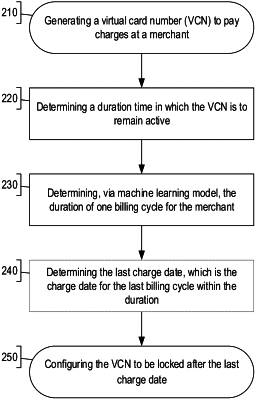| CPC G06Q 20/354 (2013.01) [G06Q 20/351 (2013.01)] | 20 Claims |

|
1. A computer implemented method comprising:
detecting, via a first application executing on a user device of a user, that the user is initiating a first transaction with a first merchant for a first charge amount on the user device, wherein the first merchant and the first charge amount are identified by the first application scraping a web page associated with the first transaction and displayed on the user device;
causing, by the first application, display of a first user interface on the user device, wherein the first user interface is a chat box allowing for communications to and from the user;
receiving, via the first user interface, an indication from the user to generate a first virtual card number (VCN) as part of the first transaction, wherein a VCN is linked to an electronic payment method associated with the user;
receiving, via the first user interface and from the user, an indication of a first duration of time for the first VCN to remain active;
receiving, by the first application and from a machine learning model trained on a plurality of incoming charge data originating from a plurality of merchants, a plurality of billing cycles for the first merchant, where a billing cycle is a time between recurring incoming charges received from a merchant corresponding to an active account with the merchant;
determining, by the first application and based on the first charge amount, a first billing cycle in the plurality of billing cycles, where the first billing cycle is associated with incoming charges similar to the first charge amount;
predicting, by the first application and based on the first billing cycle, one or more charge dates, wherein a charge date corresponds to a beginning of an iteration of the first billing cycle;
based on the one or more charge dates and the first duration of time, determining a last charge date, where the last charge date is associated with an iteration of the first billing cycle furthest in the future and within the first duration of time;
generating, by the first application and as part of the first transaction, the first VCN;
setting a deactivation date of the first VCN, wherein the deactivation date is after the last charge date;
receiving, as part of the first transaction, a preauthorization from the first merchant to the first VCN; and
deactivating the first VCN on the deactivation date, where a deactivated VCN blocks all incoming charges.
|